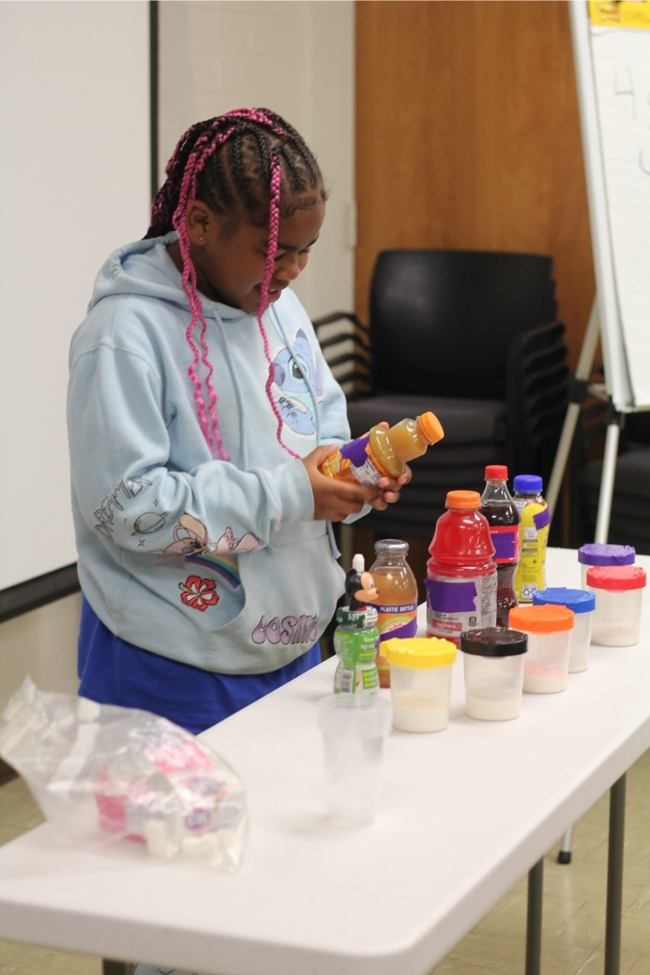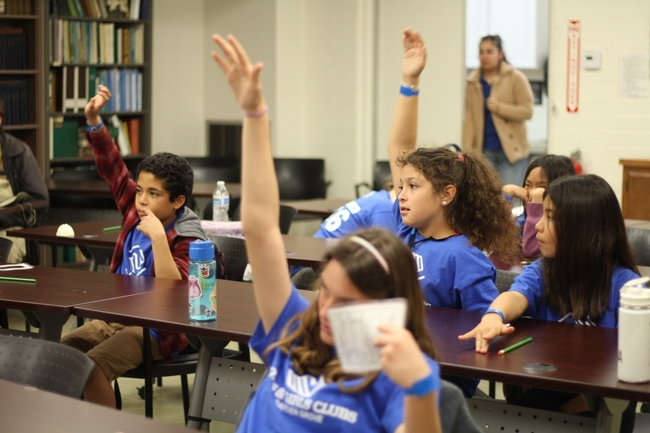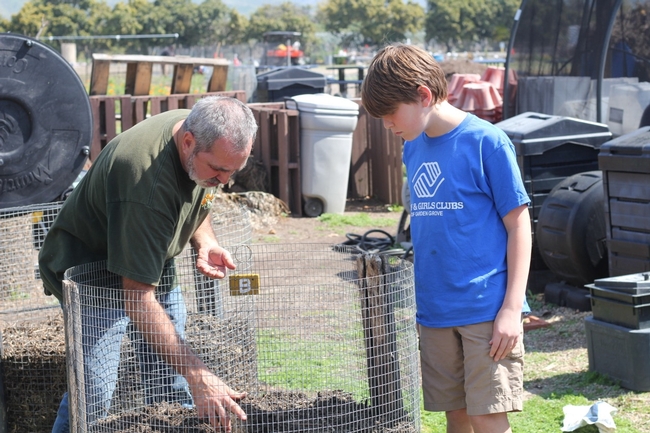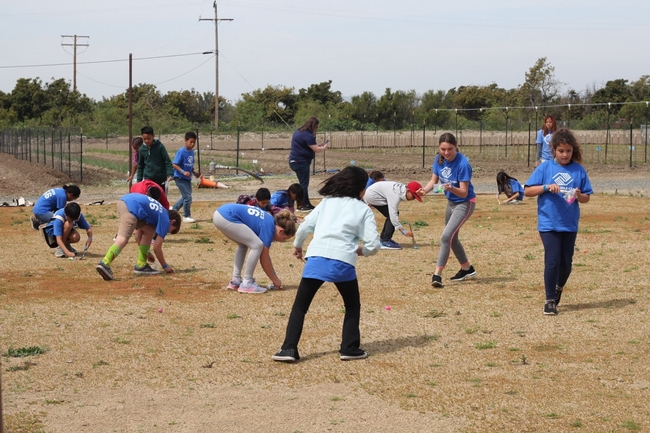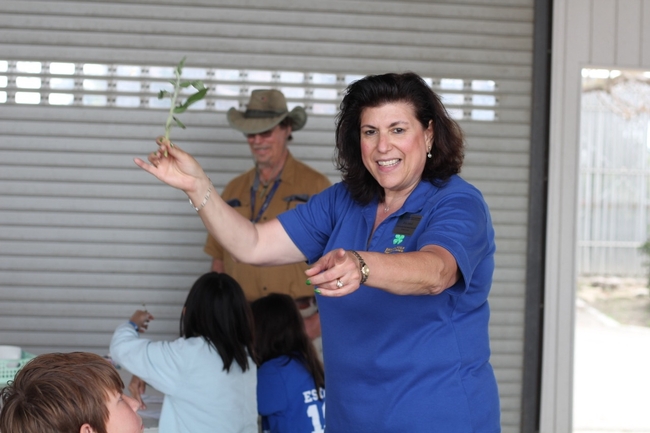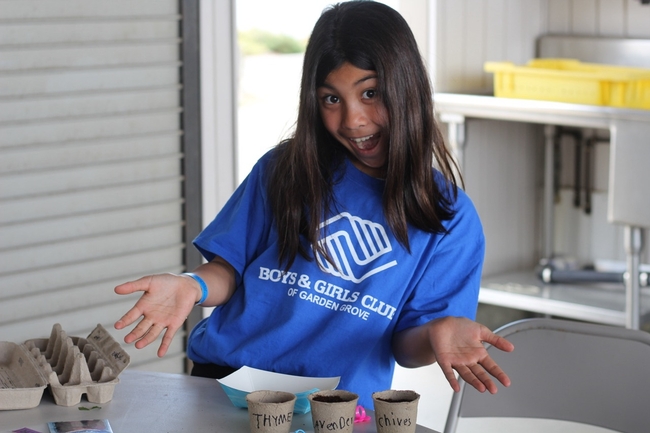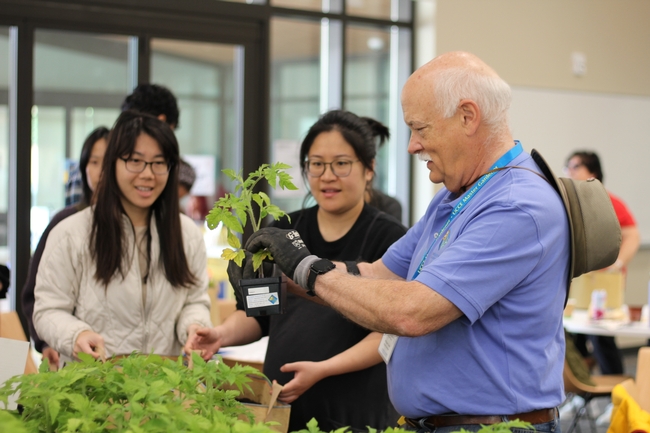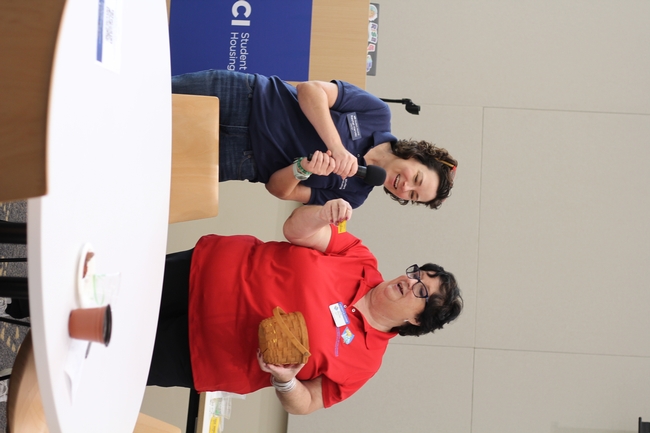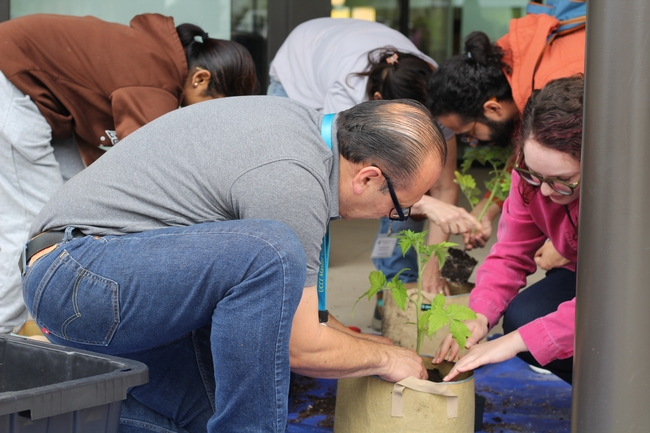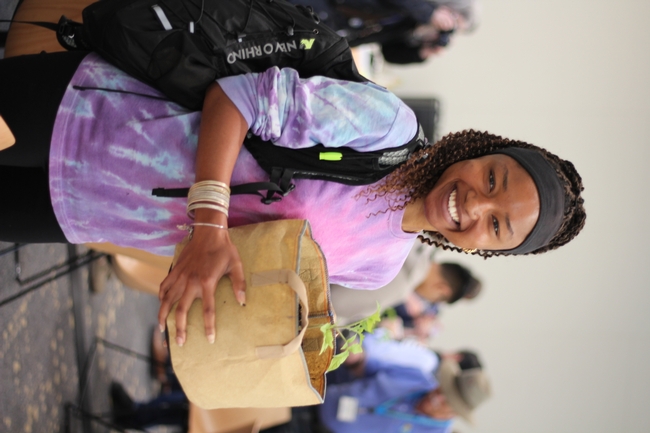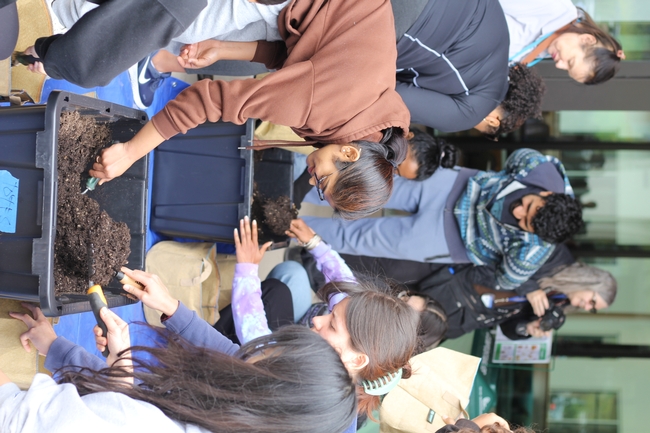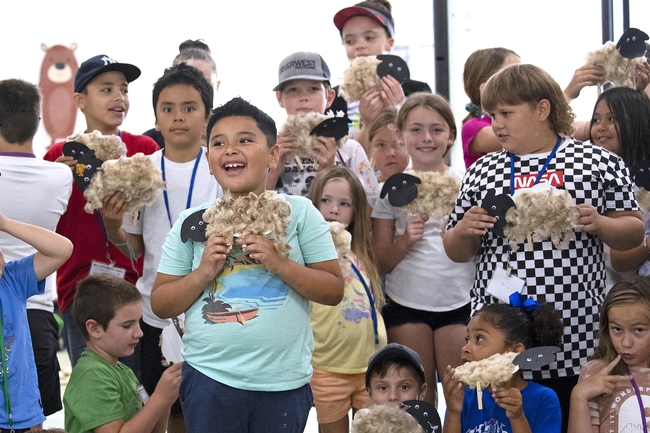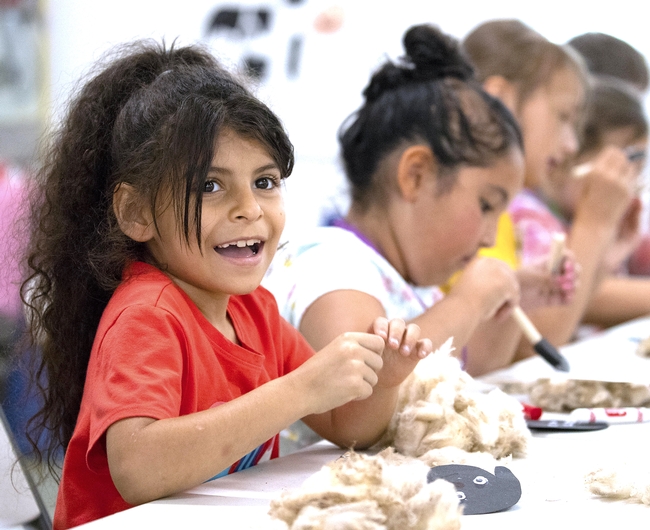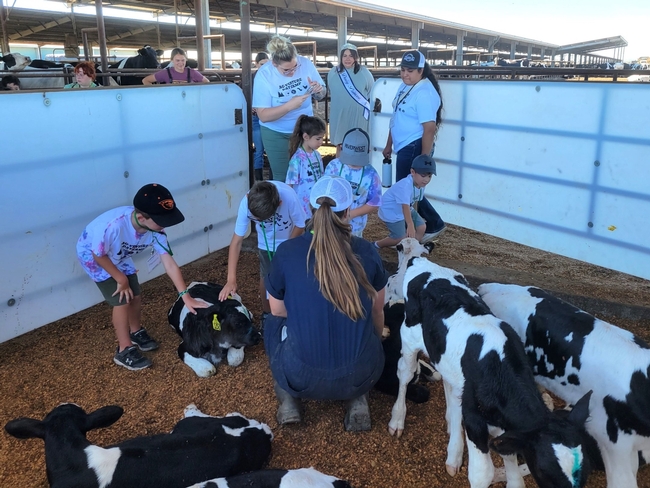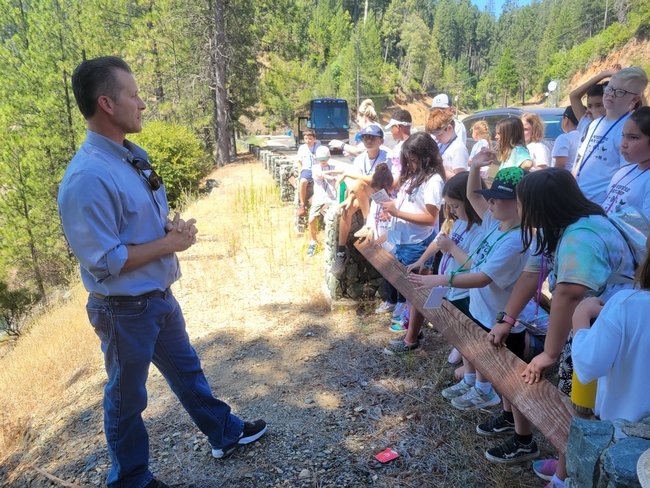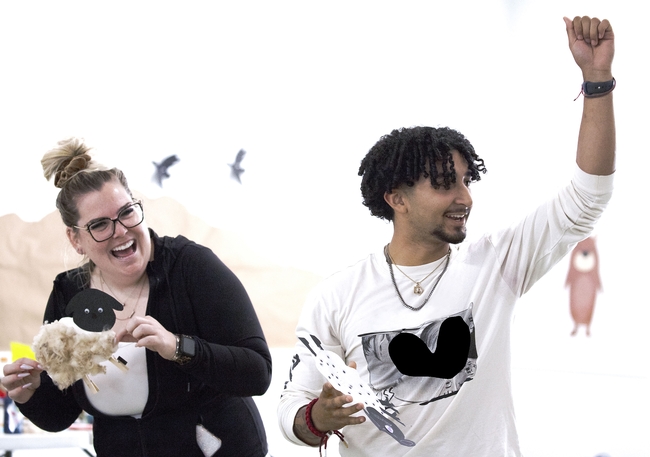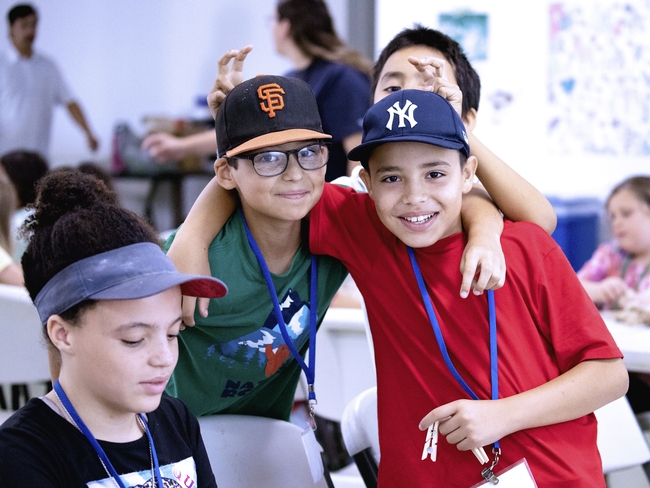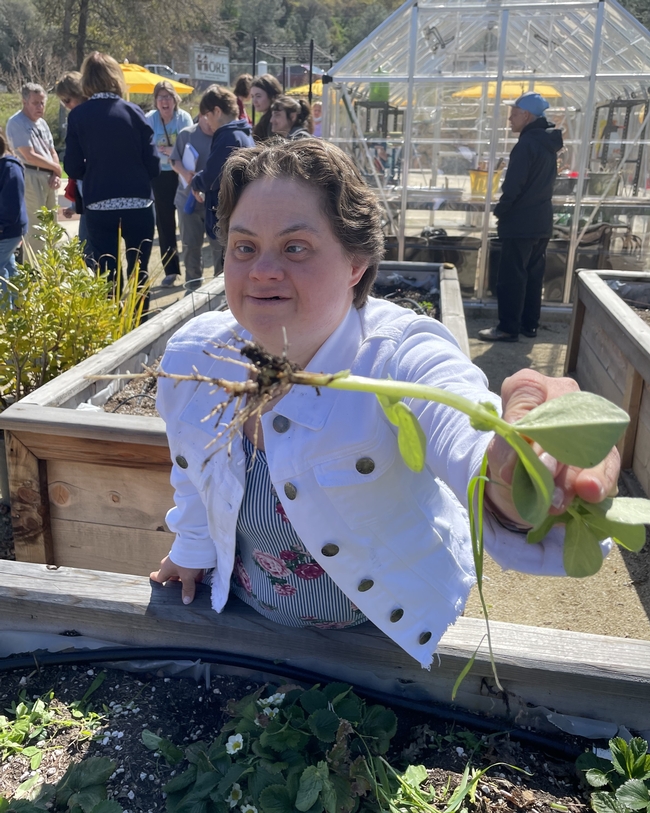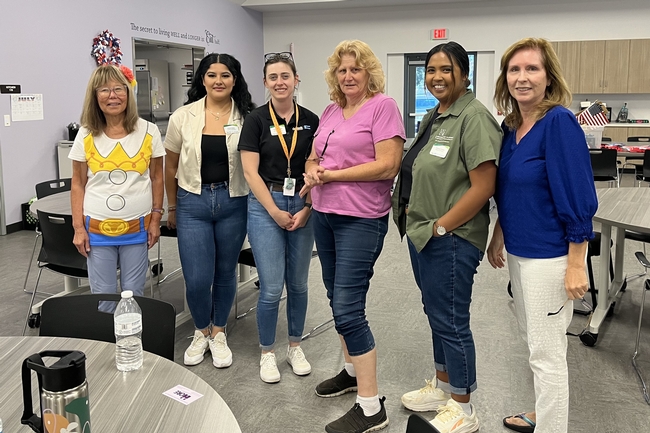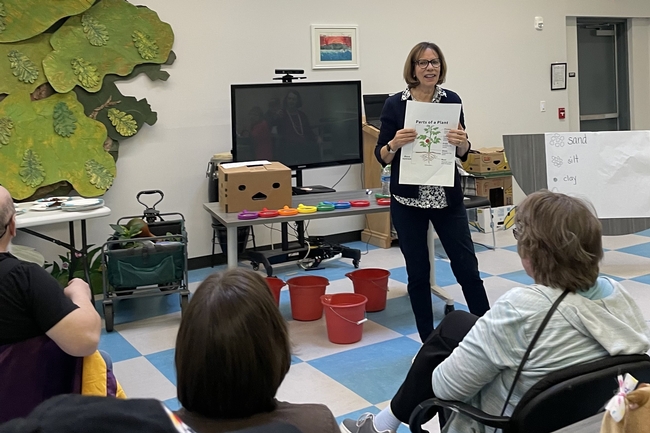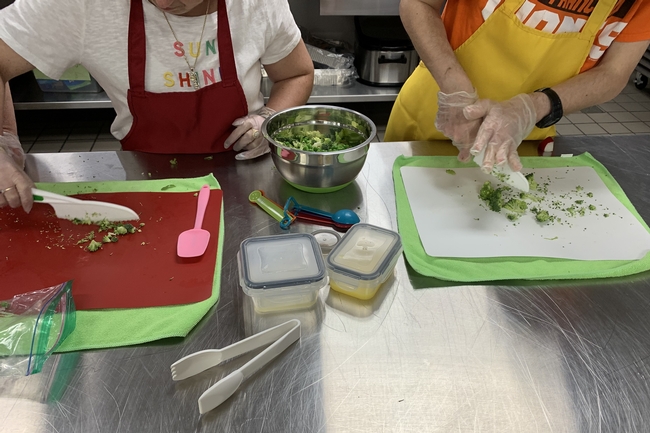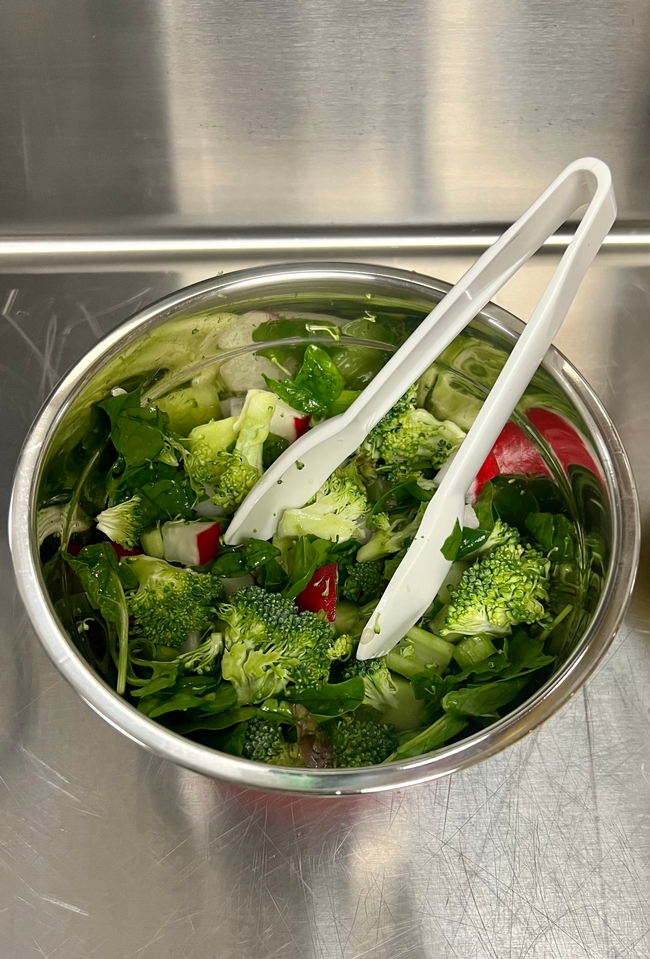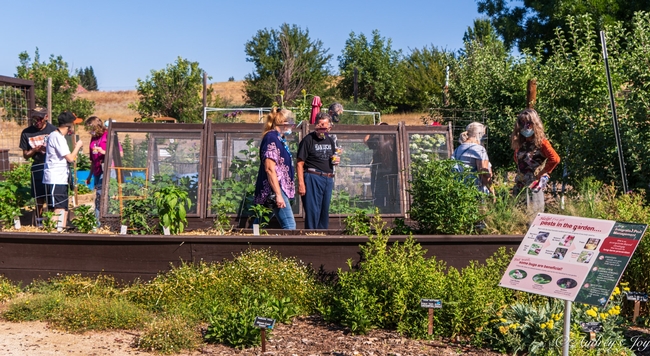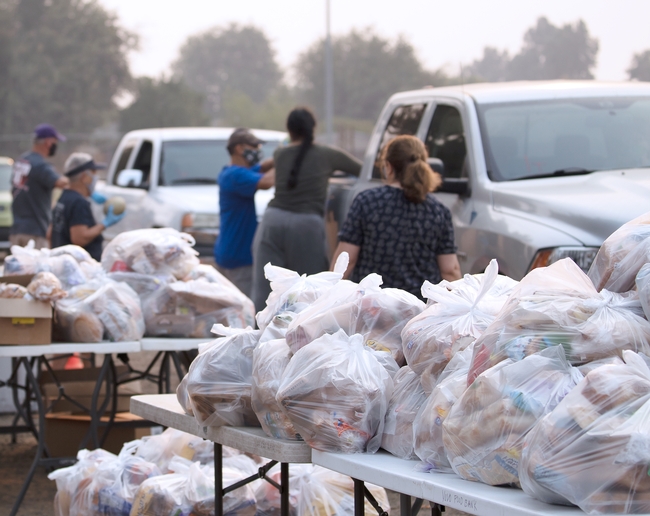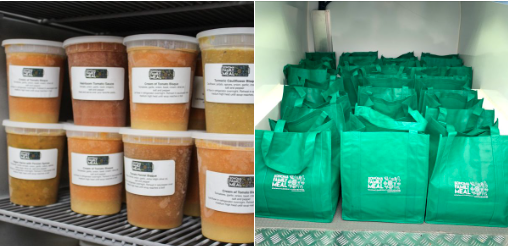- Author: Saoimanu Sope
Small containers with varying levels of sugar sit next to a row of beverages, including water, fruit juices, soda, a sports drink and chocolate milk. Trying to match each container with the beverage that contains its corresponding amount of sugar, Amore, a fourth grader, reads the nutrition label on the orange juice bottle. “What does the bottle say?” asked a student in the audience, attempting to help Amore.
Life skills such as how to read a nutrition label are representative of learning that youth can expect when joining 4-H, a nationwide program focused on empowering kids ages 5 to 18. 4-H offers experiential learning opportunities ranging from STEM (Science, Technology, Engineering and Mathematics) and healthy living to civic engagement and leadership.
To expand its reach and make their program more accessible, 4-H launched a digital learning platform called CLOVER by 4-H that offers content tailored for three types of users: learner, parent and educator. As the platform grows in popularity, 4-H is eager to identify best practices in engaging new users to join the platform and retain their interest.
More than 250 free 4-H lessons
In California, 4-H programs are overseen by University of California Agriculture and Natural Resources. Given its successful contributions to statewide initiatives in the past, 4-H in Orange County, administered through the local UC Cooperative Extension office, was one of three counties selected to participate in a CLOVER pilot project in conjunction with the National 4-H Council. With more than 250 4-H lessons available online at no cost, the pilot project aims to introduce its users to 4-H.
To generate interest, 4-H in Orange County is leveraging connections to local Boys and Girls Clubs. In March, they hosted more than 20 kids from the Boys and Girls Club of Garden Grove (BGCGG) – including Amore – for a day of learning and exploration at the UC South Coast Research and Extension Center in Irvine, where the 4-H program for Orange County is based.
Rita Jakel, community education specialist and program coordinator for 4-H of Orange County, said that partnering with BGCGG will, hopefully, inspire its members to join their local 4-H club.
“The youth created a CLOVER account before engaging in eight CLOVER lessons taught by the staff at the Boys and Girls Club during their weeklong Spring Break Day Camp,” said Jakel, noting that the participants were introduced to 4-H before arriving to South Coast REC for in-person activities.
Interactive nutrition and gardening lessons
During their visit, the participants engaged in a typical day of 4-H lessons featuring presentations from the local Expanded Food and Nutrition Education Program (EFNEP) and UC Master Gardener volunteers. Jakel then wrapped up with interactive sessions on animal adaptations—understanding the challenges animals face in gathering food—as well as lessons on growing and cooking with herbs.
“One of the most rewarding aspects of working with young people is the opportunity to creatively educate them on various subjects, ensuring that learning is both enjoyable and engaging,” said Javier Miramontes, community nutrition and health supervisor for EFNEP in Orange and Los Angeles counties, who started the day off with the lesson on nutrition labels.
Miramontes visually explained how much sugar is found in various beverages and then challenged the students to do so on their own. “It's important to me that all students participate, as engagement is key at their age, not only for inclusivity but also to maintain their focus,” he said. Miramontes concluded with a review of his lesson and was pleased that most of the class demonstrated a solid understanding of the key topics.
While the intention of CLOVER is to introduce users to 4-H in hopes that they would want to become members of their local clubs, Jakel believes that participating through CLOVER could be just as effective, if not more. “We're testing out the idea of bringing kids to our facility for typical 4-H programming. If they like it, our hope is that they'll sign up on CLOVER and gain access to our educational approach there,” said Jakel.
4-H in person and online
The goal is to give youth options so that the 4-H experience, whether in person or online, does not feel out of reach.
When discussing their collaboration, Jakel said that the BGCGG staff would continue to support interested kids and their families with CLOVER registration. The staff also agreed to conduct programming based on the digital platform at their facility to continue exposing BGCGG members to all that 4-H has to offer, which they have already reported as easy to implement and engaging among the youth.
During their time in the garden, members learned about vermiculture and how worms are essential for compost. Mary Nguyen, STEM specialist for BGCGG, said that she enjoyed watching the youth light up when they are playing in the dirt and learning about how fruits can be combined to produce new generations. To wrap up their visit to the garden, the group received a small worm box to use for their own school garden.
“I hope that more fun field trips – and hands-on activities involving research that youth can participate in – will come from our partnership with South Coast REC and 4-H,” Nguyen said.
Field trips to see, touch, smell and taste
From a UC Master Gardener's perspective, the youth were extremely interested in learning about everything and asked many questions. “I loved their curiosity,” said UC Master Gardener volunteer Laura Holly, who helped with the garden demonstration and tour of UC South Coast Research and Extension Center. “They wanted to know why certain pipes were painted purple (to indicate reclaimed water), about the windmills and how avocado trees are grafted.”
“More children would benefit from seeing how the trees that produce the fruit they eat grow,” Holly added.
Hannah, a fourth grader, said that she loved the lesson on herbs that Jakel led before the participants boarded the bus to return home. All members got to see, touch, smell and taste four different herbs before planting their own to take home. “I had a lot of fun. I think if I had to grow one thing, it would be chives. They actually taste really good,” Hannah said.
Amore, who knew what lavender smelled like before, had never seen a lavender plant. “My mom loves lavender, but I didn't know this is what it looks like. I planted some lavender to take home for her,” she said.
The partnership with BGCGG is one of many that Jakel hopes to foster in Orange County, in addition to uniting UCCE programs to enrich the learning experience for youth who visit South Coast REC and those enrolled in the 4-H program. Her goal, in line with that of CLOVER, is to make 4-H programming more accessible for the youth, parents and educators alike.
To learn more about 4-H in Orange County, visit https://oc4h.org/.
- Author: Saoimanu Sope
Although training is required to become a University of California Master Gardener, the benefits of gardening can be experienced by anyone and everyone.
“As long as you're willing to get your hands dirty,” said Laurie Menosky, a UC Master Gardener volunteer in Orange County, “you can learn to grow all sorts of things.”
In early April, Menosky partnered with ETN Medical Infusion (a clinic in Orange County) and the Sustainability Program for Student Housing at UC Irvine to teach students how to grow tomatoes. Menosky welcomed all in attendance, including families with toddlers who seemed fascinated by the 60 tomato plants atop one of the tables in the room.
The UC Master Gardener Program is a part of UC Agriculture and Natural Resources. During her presentation, Menosky taught participants how to choose varieties that fit their taste and growing environment, how to cultivate a thriving environment, and how to control pests and diseases using integrated pest management practices.
“We have 16,000 residents at UCI and sustainability is one of our values. One of the ways we engage students is through on-campus gardens,” said Rachel Harvey, sustainability program manager for UCI Student Housing and a UC Master Gardener volunteer in Orange County.
UC Irvine has one teaching garden reserved for undergraduate learning, and three gardens operated and maintained by graduate students. “I was on the waiting list for a garden plot for a while, but it was totally worth the wait,” said Johanna Rinaman, a fifth-year Ph.D. student studying physical chemistry.
While the highlight of the event for many people was the opportunity to take a tomato plant home, another important takeaway was how gardening can be a good activity for your mental health. Sarah Nghiem, family medicine specialist at ETN Medical Infusion, who worked closely with Menosky, was instrumental in developing the mental health content for the day, encouraging attendees to attempt gardening with a mental health perspective.
Nghiem and her team received funding from the Orange County Health Care Agency through the Mental Health Services Act to work with transitional aged students (15-24 years-old) on understanding the importance of mental health, which led to the collaboration between UC Irvine, her alma mater, and the UC Master Gardeners of Orange County.
“I didn't do any gardening during the winter, and I felt a lot more anxious and depressed during that time,” Rinaman said. “I know gardening improves mental health because I've immediately felt a difference whenever I spend time with plants.”
Rinaman, whose father taught her a lot of what she knows about gardening, said that having access to a 4 feet by 6 feet plot to grow her own food is one of the many things she loves about UC Irvine.
Like Rinaman, Menosky turns to gardening to decompress, especially during the long days of summer. Teaching others about the physical and mental benefits of gardening gives her an opportunity to share her experience and, hopefully, help others find new ways to manage stress.
“We often have attendees come back years later telling us how our information has helped them and how much more they are enjoying their time in their gardens,” she said.
To conclude her presentation, Menosky instructed participants to line up for their own tomato plant. Attendees took their plants outside to transfer them from a small pot to a grow bag – a type of container that helps root structure development.
Cassie Ekwego, a third-year transfer student studying civil engineering, couldn't hide her excitement after carefully lifting her plant. “I don't think I realized how attentive you need to be when working with plants,” said Ekwego, reflecting on what she learned from Menosky's presentation.
Now that she has her own plant to care for in her own home, Ekwego is eager to put her new knowledge to the test. “I love tomatoes, but this is going to be a huge responsibility for me,” she said.
Randy Musser, UC Master Gardener program coordinator for Orange County, said that while he enjoys talking to avid gardeners, bringing gardening to new people in the community is special to him. “This tomato workshop is particularly exciting for me because it is an opportunity for the UC Master Gardeners to grow our connection to UCI and young people just starting off on their gardening journey,” said Musser.
With a generous contribution from UC Master Gardener volunteer Sheila Peterson, Musser was able to purchase enough supplies to help attendees, like Ekwego, jumpstart their gardening experience.
Students, whose stress levels can skyrocket throughout the school year, value opportunities to be outdoors, try something new and be in community. “The garden is a different type of classroom. It's a place where students can learn and experiment, hopefully in a way that reduces stress,” said Harvey of UCI Student Housing.
Ekwego, who tried gardening for the first time while volunteering at UC Irvine's teaching garden, is just one of the many students inspired by their experiences. “Gardening reminds me that it's OK to get my hands dirty,” Ekwego said.
- Author: Mike Hsu
UC Cooperative Extension team in Sutter and Yuba counties showcases UC ANR programs, community partners
When dozens of elementary schoolers gathered to watch a live calf birth at Tollcrest Dairy in Yuba County, their comments ranged from “disgusting but cool” to “I saw something that maybe I'm too young to see.”
Expanding horizons, growing knowledge and gently pushing some limits were at the heart of a four-week day camp, Ag-Venture, organized by the University of California Cooperative Extension office serving Sutter and Yuba counties.
Throughout July, more than 80 campers – ages 5 through 12 – explored agriculture and science topics through field trips across the region, hands-on activities and lively presentations by UCCE advisors, UC Master Gardeners, 4-H specialists, UC Master Food Preservers and CalFresh Healthy Living, UC educators. All these groups fall under the umbrella of UC Agriculture and Natural Resources.
A grant from The Center at Sierra Health Foundation funded this day camp for underserved youth focused on agriculture and natural resources – the first of its kind in the area. Exploring the themes of “Interesting Insects,” “Foods and Farms,” “Woods and Water” and “Awesome Animals,” the campers learned directly from community experts and UC ANR scientists.
“Some of the kids might think scientists are only wearing lab coats and working with genetics and DNA and human-based science, but here they got to see agricultural scientists and natural scientists,” said Rayna Barden, the 4-H community education specialist who led the camp. “It was a cool way to showcase what ANR does and what we have to offer.”
Youth gain wide range of experiences, knowledge
Visits to local farms and ranches – with many chances to greet the animals – were a highlight for many of the camp participants.
“I liked learning about agriculture and the interactive activities,” said a fourth grader. “I saw a baby cow coming out of its mama, and they [farm staff] had to use a tool. It was cool.”
A sixth grader said: “I learned that feed is made up of everyday items, like almond shells and beer hops!”
“Sheep, cows and goats have one stomach and four chambers,” added another sixth grader.
That digestive tidbit was absorbed by the campers after a visit with UCCE livestock and natural resources advisor Dan Macon at Sierra Foothill Research and Extension Center, a facility operated by UC ANR in Browns Valley.
“We have 4-H kids and FFA kids in high school who still don't know how the four chambers work!” Barden said. “These kids had it and it was so cool to see that they remembered that from a previous day.”
Time and time again, Barden said she was amazed at how much the campers retained. After a visit to Bullards Bar Reservoir, a seven-year-old was able to explain why the dam is curved. Another young boy could draw his own interpretation of the water cycle. And several campers talked about the rice presentation for weeks.
Whitney Brim-DeForest, UCCE county director for Sutter and Yuba counties and a rice advisor, had the participants touch and feel different rice seeds and varieties. The campers also got to plant a few rice seeds to take home.
“But their favorite part – and what they talked about for the rest of camp – was the tadpole shrimp,” Brim-DeForest said. “We brought some live and preserved specimens, and they loved them!”
Sparking ideas for future careers
One third-grade camper said she enjoyed learning the differences between agricultural pests and beneficial insects.
“And you can do stuff to help the good bugs,” she said, adding that she would like to pursue a career working with animals and nature.
Expanding awareness among young people of new career possibilities was exciting for Ricky Satomi, UCCE forestry and natural resources advisor for Sutter and Yuba counties. Using interactive exercises (such as those developed by California Project Learning Tree, another UC ANR-affiliated program), Satomi shared his knowledge about resource competition, watershed filtration and fire behavior in forest ecosystems.
“It's always a pleasure to introduce students to the natural resources where they live,” Satomi said. “This is particularly critical given the current workforce shortage we face in forestry; I hope their experience at Ag-Venture will spark interest in future forestry careers, where these students can work to better their local forest communities.”
Young people from local colleges and universities also gained invaluable experience during the camp. Four students helped prepare the camp: Yasmeen Castro Guillen (Chico State), Alana Logie (Yuba College), Jayla Pollard (Folsom Lake College) and Adam Yandel (Chico State). Three more helped lead the camp as counselors: Hector Amezcua (Yuba College), Alyssa Nott (Butte College) and Jillian Ruiz (Chico State).
“They did such a fantastic job, mentoring the kids and serving as positive role models, and we have seen tremendous growth in all of them, too – in confidence, skills and knowledge,” said Brim-DeForest.
A true community effort
Barden emphasized that the sweeping scope and in-depth, intertwining lessons of the camp were only possible through broad support from the greater community. Brim-DeForest highlighted the partnership with Yuba City Unified School District, as well as with Sutter County. Camp HQ was in Ettl Hall, a Sutter County building; campers visited the Sutter County Museum; they also met Yuba-Sutter public health officer Dr. Phuong Luu.
Additional collaborators included Melissa Ussery, CalFresh Healthy Living, UC nutrition program supervisor; Rene McCrory, 4-H secretary; Johnny Yang, UC Master Gardener and Master Food Preserver program coordinator; Matt Rodriguez, 4-H youth development advisor; and Nicole Marshall-Wheeler, 4-H youth development advisor.
“Honestly, we could plan all of this, but without the community's support, our program never would have worked smoothly,” said Barden, who grew up in the small town of Sutter. “Having all of our guest speakers, having all the people who were willing to have up to 50 kids on their property – it just shows how much our community is about our youth.”
Brim-DeForest said Sandy Parker, the camp nurse, exemplifies that spirit. A UC Master Gardener and 4-H alumna and volunteer, Parker also invited the campers to her family ranch, where she introduced the children to her farm animals and Great Pyrenees guardian dog.
The campers certainly appreciated the generosity, teamwork and energy that went into Ag-Venture. Barden said that many of the participants originally had only signed up for one or two weeks – but loved the camp so much that they asked to register for more. And she added that the “vast majority” of them said they want Ag-Venture to come back and would attend in the future.
“Our youth are just so resilient and so willing to learn,” Barden said, reflecting on the camp overall. “Whereas adults, we're usually a little more timid at things, these kids just were willing to dive in, head first, and be in that moment and try to take away as much as they could from what they were offered there at camp.”
- Author: Mike Hsu
CalFresh Healthy Living, UC and UC Master Gardeners partner with nonprofit MORE in El Dorado County
A nonprofit serving adults with intellectual and developmental disabilities in El Dorado County, MORE has found kindred spirits in helping their clients live fuller and healthier lives – the staff and volunteers of University of California Master Gardeners and CalFresh Healthy Living, UC.
Since 2018, these programs – both affiliated with UC Agriculture and Natural Resources – have helped enrich the lives of about 60 clients at MORE, which offers services ranging from independent-living skills development to job training and placement.
“This is exactly the kind of partnership that we like to make with the community,” said MORE CEO Susie Davies, who has been with the Placerville-based organization for 40 years. “This has just been incredible; our people have learned above and beyond what we could even have imagined in nutrition and gardening.”
The three-party partnership, which Davies calls a “win-win-win,” offers a course that combines gardening and nutrition lessons, as well as a new cooking and food safety-focused class developed by educator Cailin McLaughlin in collaboration with MORE staff.
During one session, MORE clients enjoyed preparing a “plant part salad,” following a botanical lesson on the edible components of plants – fruits, roots, leaves, seeds and stems. “It was fun to cut the celery and broccoli,” said Jared (first names are used to protect privacy). “I like pouring the sauce in.”
“I liked everything about creating the salad,” said Deanne, another participant.
“MORE is the dream site, the best you could ever hope to go to, with the programming and the clients always being lovely and really just being down for anything,” said McLaughlin, a CalFresh Healthy Living nutrition educator at the Central Sierra UC Cooperative Extension office. “It's just a really cool place to be.”
CalFresh Healthy Living, UC is one of the organizations in California that teaches nutrition to people eligible for SNAP (Supplemental Nutrition Assistance Program). UC Davis administers the SNAP-Ed grant and UC Cooperative Extension educators deliver the lessons throughout the state.
‘Part of our MORE family'
Through the gardening and nutrition program, clients learn and apply their skills in the garden and greenhouse at the MORE facility and in the nearby Sherwood Demonstration Garden maintained by UC Master Gardeners of El Dorado County.
“The participants get a chance to harvest, plant, pull weeds and learn about integrated pest management, both in the vegetable garden and in the orchard,” said Tracy Celio, the local UC Master Gardeners program manager who worked with former CalFresh Healthy Living, UCCE educator Miranda Capriotti to develop the program.
“It's a very good program,” said Tony, a MORE client. “I can learn things.”
While experiencing the pride in bringing fresh produce to their home or to the MORE kitchen for use in the meal service, the clients are also taking away nutritious and healthy recipes. Jordan Postlewait, director of community access programs at MORE, said participants now know how to use ingredients from the garden to create dishes such as tomato salsa and fruit salad.
“They've taken the recipes that Cailin has given them and they go home and serve their whole group home what we had made for a snack,” Postlewait said. “They are paying attention to what they're eating.”
As a result of this awareness and knowledge of nutritious foods, Davies said that MORE clients are healthier, more energized and alert, and ready to learn. She is quick to credit the expertise and enthusiasm of McLaughlin, CalFresh Healthy Living, UCCE program coordinator Mariana Garcia, and the UC Master Gardeners staff and volunteers.
“They have the same dedication and commitment to excellence in their preparation for every session as our staff,” Davies said. “They just became part of our MORE family.”
“I like seeing Cailin and Tracy and all the staff who are my friends,” said Kenion, a MORE client.
Cooking lessons create possibilities for kitchen time, jobs
In April, two groups, each composed of six people, began participating in a new five-session course combining nutrition, food safety and basic cooking techniques. Each two-hour session included a nutrition lesson, a physical activity and time in MORE's commercial kitchen.
“It was fun getting in the kitchen and learning how to prepare my own meals,” Jared said. “I learned how to safely use a small skillet.”
Another participant, Kyle, said he uses the recipes to cook for his roommates. “I liked learning new cooking skills and recipes,” he said.
McLaughlin adapted a youth-oriented healthy eating curriculum, approved for use by CalFresh Healthy Living, UC, and tailored it for adults at MORE.
“The whole goal is to get them closer to an independent living circumstance, where either they can live in a group facility or have their own apartment – and knowing how to cook and identify healthy recipes is a huge component of that,” McLaughlin explained.
The guided kitchen experiences – and equipment like plastic safety knives – not only benefit the participants but also give their family members reassurance and confidence to include them in meal preparation.
“We've actually been asked by staff at MORE, and also by clients' parents, where we got the knives, because they would like to have their family member in the kitchen with them, if they can do it safely,” McLaughlin said. “They didn't know things like safety knives existed; they didn't know you could adapt a silicone food guard to keep them from burning themselves on a burner.”
In addition to enhancing the clients' family time, the cooking lessons could also set them up for future employment. Davies said she is in talks with a local chef about establishing a culinary training for the clients.
“This cooking program could be a preparation program for them to be involved in the culinary training program,” she said. “That's what we're really excited about.”
McLaughlin added that, for future sessions of the cooking and food-safety series, past participants have expressed interest in serving as kitchen aides and mentors.
Partners nurture clients' relationships with nature, community
Empowering clients with new skills and fostering a sense of ownership of the garden are both cornerstones of the partnership programs. Beginning in 2019, participants from MORE each adopted a tree in the Sherwood Demonstration Garden orchard to monitor and nurture.
“Almost every time they come to the garden, we check those fruit trees,” Celio said. “The trees are doing so many things throughout the year, so they're following the cycle: they watch the leaves drop; they watch the fruit come in; they see what a freeze does to their tree; they see what pests do to their tree.”
The participants experience the challenges of gardening – from managing rabbits and squirrels to coping with the loss of a pear tree due to disease – as well as its many joys.
“I liked seeing the butterflies and different plants; the butterflies drink from the bushes,” said Jen, a MORE client. “My favorite thing is the rose garden.”
At the same time, the clients have built strong relationships with the core group of UC Master Gardener volunteers and the dozen or so “vegetable garden crew” volunteers. Celio stressed that the garden programs, which were recently recognized by the statewide UC Master Gardeners program with a Search for Excellence Award, are truly collaborative.
MORE participants often bring their own ideas; one man, for example, became interested in composting and worked with MORE staff to establish a worm bin at the MORE facility garden.
“Every time I see that client, he will tell me how the worms were doing and he'll tell me how healthy the plants are that are growing next to the worm bin,” Celio said, adding that he also worked at a table during a MORE fair, teaching other clients and their family members about vermiculture.
Advocating for the greater good of the community is central to another CalFresh Healthy Living, UC collaborative project at MORE, in partnership with Stanford University's Our Voice initiative. Using an online tool and app, 12 clients have been taking photos and sharing feedback on their health and wellness experience at MORE, specifically about their walking trail. With that information, they are building a case to make the path safer and more enjoyable.
Responding to their feedback, along with the other partnership programs that are building vital skills and community, demonstrate to MORE's clients that they are appreciated and respected.
“The request from the people that we serve is that they want to be seen, they want to be heard, and they want to be valued by other community members,” Davies said. “And this is really showing them that they are valued and being seen and heard.”
- Author: Pamela Kan-Rice
New food systems partnership to aid disaster response in Del Norte, Humboldt, Mendocino, Sonoma, Napa and Marin counties
To improve people's access to food during disasters, University of California Cooperative Extension advisors Dorina Espinoza and Julia Van Soelen Kim received a combined $1.5 million from the USDA Agricultural Marketing Service Regional Food Systems Partnership Program and crucial matching contributions from local government, nonprofits and foundations. Over a three-year period, they will create a California North Coast Emergency Food System Partnership across six counties – Del Norte, Humboldt, Mendocino, Sonoma, Napa and Marin – to strengthen local and regional food systems and build community resilience.
“We wouldn't have been able to access these funds without UC providing the backbone,” said project partner Suzi Grady of Petaluma Bounty, an urban farm and food security project. “The trusted relationship with UC allows us to broaden our reach and scope; the neutrality piece is also really important. It's a natural fit for UC to step in.”
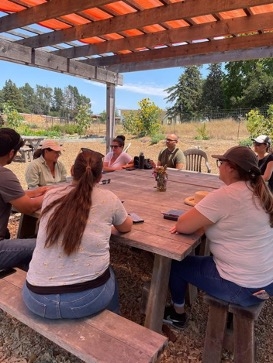
Grady added, “I'm excited by this opportunity because UC can provide evaluation, reflect back to us what happens in disasters, and help build our collective capacity when those of us who are busy doing are too busy to step back and reflect. Having academic partners helps us retain institutional knowledge, learn from the past and strategize for the future."
Meredith Knowles with the Del Norte and Tribal Lands Food Security Project agreed, “I have seen so many times that the relationship building, coordinating and making space for sharing is so important and the momentum that comes from that is powerful. I'm excited for the space to share that.”
Learning from past disasters
Following earthquakes in Humboldt County last December, UC Cooperative Extension advisor Espinoza took part in the Community Organizations Active in Disaster or “COAD,” collaborating with local government, agencies and organizations to support a Local Assistance Center in Rio Dell, the town hit hardest by the quakes.
Espinoza and partners worked to connect impacted neighbors with local, state and national services, including ensuring community members could access food right in their community through the local food bank and local food trucks, which prepared meals for residents who were unable to use their kitchens.
In January, with storms in the forecast, Mimi Enright, UCCE Sonoma County community food systems program manager, activated the COAD's Emergency Food Group in Sonoma County. She discussed with Van Soelen Kim, UCCE North Bay food systems advisor, as well as local emergency food providers, how their network could respond to food needs that might arise if flooding occurred.
“Before the storm, we met and asked, ‘What populations might be most impacted? What organizations might be offline because of the storm? Who will be able to deliver groceries and meals to sites in the community?'” Enright explained.
Further north in Del Norte County along the Oregon border, there are limited entry points and no major highways, leaving the region vulnerable to natural disasters. Road access to and from the county is frequently blocked by landslides, wildfires and floods, resulting in disruptions to food deliveries.
The Del Norte and Tribal Lands Community Food Council – a group that works to build a more local food system by providing healthy, culturally appropriate food to families – learned from past closures and from the pandemic the importance of having local and regional systems in place to better respond to the emergencies that impact the isolated area of the state. Their Choice Pacific Pantry includes local products in its food distribution programs and their Pacific Fresh Mobile Market brings food directly to vulnerable rural communities with limited access to nutritious food.
Over the past five years, Northern California has experienced catastrophic wildfires, floods, landslides, drought, earthquakes and the pandemic, all of which have put increasing pressure on local producers, the local/regional food system and emergency food aid.
“Food is implicated in every disaster,” said Patti D'Angelo Juachon with the Marin Community Foundation.
Through the various challenges to their communities, Espinoza, Enright and Van Soelen Kim have extended their expertise related to emergency food systems. Collectively the UCCE team has gained firsthand knowledge about what works well and what doesn't in getting local food to food-insecure community members. They hope to share this knowledge with partners regionally and expand collaboration at a larger scale.
“Local food production is critical to the resilience of the North Coast,” said Lynda Hopkins, Sonoma County District 5 supervisor. “I'm thrilled that UCCE will be working with our farmers to ensure that we can feed our residents healthy, local food no matter what disaster we're facing – be it future flood, fire or pandemic. This is a huge step towards food security for Northern California!”
Collaborating across the North Coast
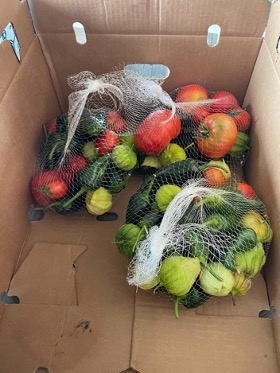
“The Regional Food Systems Partnership Program will help to build a more resilient and stable food system in times of disaster and in times of stability,” said Heather Irwin, founder of Sonoma Family Meal. “This is very important work for the future of Northern California disaster relief efforts, and we are excited to be part of it. During disasters, Sonoma Family Meal coordinates resources between the restaurant industry and emergency meal providers in order to provide quality emergency meals for those who have been impacted.”
One way the team hopes to strengthen local and regional food systems is by reducing the risk of lost income and creating additional market channels for local food producers in emergency food supply chains. The team also plans to create a network of partners, develop emergency feeding plans, and inventory local emergency food supply chain infrastructure. They also plan to create recommendations for policies and practices that support local/regional emergency food supply chains.

